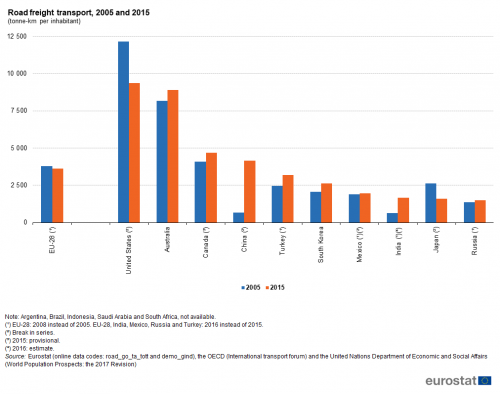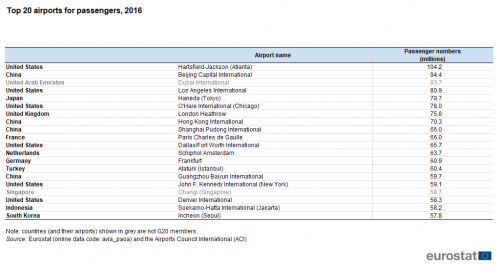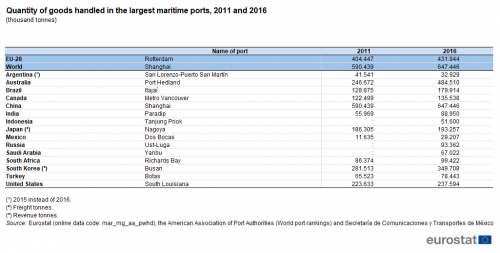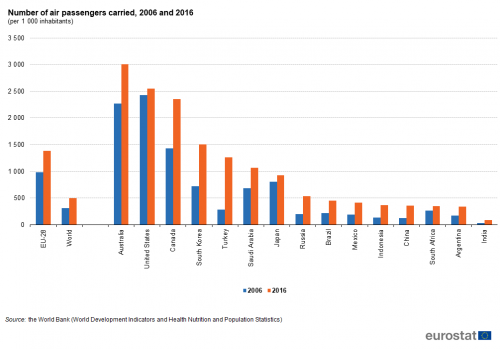Archive:The EU in the world - transport
Data extracted in April 2018.
Planned article update: June 2020.
Highlights
Rail freight transport increased strongly in India and Canada between 2005 and 2015.
In Turkey, the number of air passengers relative to population size was 4 times as high in 2016 as in 2006.
Shanghai was the largest maritime port in the world in 2016, while Rotterdam was the largest in the EU.

(per 1 000 inhabitants)
Source: Eurostat (demo_gind), the International Organisation of Motor Vehicle Manufacturers and the United Nations Department of Economic and Social Affairs (World Population Prospects: the 2017 Revision)
This article is part of a set of statistical articles based on Eurostat’s publication The EU in the world 2018.
The article focuses on transport statistics in the European Union (EU) and the 15 non-EU members of the Group of Twenty (G20). It provides information on freight and passenger transport, as well as on the stock of passenger cars and gives an insight of the EU’s transport sector in comparison with the major economies in the rest of the world, such as its counterparts in the so-called Triad — Japan and the United States — and the BRICS composed of Brazil, Russia, India, China and South Africa.
Two particular units are used for transport measurement — tonne-kilometre (tonne-km) and passenger-kilometre (passenger-km) — representing the transport of one tonne of goods (freight) or one passenger over a distance of one kilometre.
Full article
Rail transport
Concerning the use of rail transport (see Figures 1 and 2), the G20 members can be split into several groups depending on the extent to which this mode is used for passenger and/or freight transport. Saudi Arabia, Turkey and Indonesia had a relatively low overall use of rail transport. In Canada, the United States, Mexico, Canada, Australia and Brazil, rail transport was focused mainly on freight transport, while passenger transport was dominant in Japan and South Korea. A relatively high use of rail transport for both freight and passengers was observed in Russia, South Africa, China, the EU-28, India and to a lesser extent Argentina.
Comparing the data for the two years shown in Figure 1, apart from the increase recorded in Mexico which was large in relative terms but small in absolute terms (despite the strong relative growth it had the lowest value of rail passenger transport relative to population size among the G20 members), growth was strongest in India, up 74 % overall between 2005 and 2015, while double digit growth rates were observed in Russia, China and the EU-28 during the same period. The United States recorded growth of 9.2 %. The remaining G20 members reported decreases in the use of passenger rail services during this period, with these exceeding 25 % overall in South Korea, Indonesia (2005-2014) and Saudi Arabia (2005-2014) and exceeding 50 % in Canada.
(passenger-km per inhabitant)
Source: Eurostat (rail_pa_total) and (demo_gind) and the World Bank (World Development Indicators and Health Nutrition and Population Statistics)
Rail freight transport increased strongly in India and Canada between 2005 and 2015
Turning to rail freight services relative to population size, between 2005 and 2015 the largest percentage increases among the G20 members were recorded in India and Canada, both increasing by more than 40 % overall. Relatively large increases were also observed in Indonesia (2005-2014), Russia (2005-2016), Saudi Arabia (2005-2014) and Mexico, although the overall level of rail freight services relative to population size remained low in both Indonesia and Saudi Arabia. Estimates for the EU-28 show a 3.1 % decrease in rail freight transport per inhabitant, while South Korea, Argentina (2006-2014) and the United States all reported decreases in excess of 10.0 %.
(tonne-km per inhabitant)
Source: Eurostat (rail_go_typeall) and (demo_gind) and the World Bank (World Development Indicators and Health Nutrition and Population Statistics)
Road transport
More than 500 passenger cars for every 1 000 inhabitants in 2015 in Canada, Australia and the EU-28
Passenger cars are road motor vehicles, other than mopeds or motor cycles, intended for the carriage of passengers and designed to seat no more than nine persons (including the driver); light commercial vehicles are excluded.
Among the G20 members, ownership of passenger cars was highest in 2015 in Canada, Australia and the EU-28, all of which had more than 500 passenger cars for every 1 000 inhabitants; the lowest ratios were recorded in South Africa, China, Indonesia and India, all below the 128 cars for every 1 000 inhabitants world average.
A general upward trend was observed in nearly all G20 members between 2005 and 2015. In relative terms, by far the fastest growth in the ratio of passenger cars to population was recorded in China, as this ratio was more than six times as high in 2015 as in 2005. The number of passenger cars per 1 000 inhabitants also more than doubled in India and Indonesia (see Figure 3). South Africa, Canada, the EU-28, Japan and Australia recorded growth in this ratio that was below the world average (28.3 %), while the United States was the only G20 member to record an actual fall in the ratio of passenger cars to population between 2005 and 2015, down 15.1 % (or 68 passenger cars per 1 000 persons).
(per 1 000 inhabitants)
Source: Eurostat (demo_gind), the International Organisation of Motor Vehicle Manufacturers and the United Nations Department of Economic and Social Affairs (World Population Prospects: the 2017 Revision)

(tonne-km per inhabitant)
Source: Eurostat (road_go_ta_tott) and (demo_gind), the OECD (International transport forum) and the United Nations Department of Economic and Social Affairs (World Population Prospects: the 2017 Revision)
Air transport
Worldwide, the number of air passengers carried in 2016 was around 3.7 billion, an overall increase of 78 % compared with 2006. Relative to the size of the population, the world number of air passengers in 2006 was 314 per 1 000 inhabitants and this ratio increased by 58 % to 497 per 1 000 inhabitants in 2016 (see Figure 5).In Turkey, the number of air passengers relative to population size was 4.4 times as high in 2016 as in 2006
In 2016, the highest ratio of air passengers to population among the G20 members was 3 009 per 1 000 inhabitants in Australia, followed by the United States and Canada with 2 547 and 2 354 per 1 000 inhabitants respectively. South Korea, the EU-28, Turkey and Saudi Arabia all reported more passengers carried than their number of inhabitants. At the other end of the ranking, India was the only G20 member where there were less than 100 air passengers per 1 000 inhabitants in 2016.
Several G20 members recorded a fall in their number of air passengers in 2008 and/or 2009, at the peak of the financial and economic crisis, but overall between 2006 and 2016 all of the G20 members recorded faster growth for the number of air passenger than for inhabitants, such that the ratio shown in Figure 5 increased. During this period, the number of passengers relative to population size grew (in percentage terms) most strongly in Turkey where it more than quadrupled, while it more than doubled in a majority of the G20 members. The weakest overall growth was reported for Japan (15 %) and the United States (5 %).
In terms of passenger numbers, the busiest airport in the world in 2016 was Hartsfield-Jackson Atlanta
In terms of passenger numbers, the busiest airport in the world in 2016 was Hartsfield-Jackson Atlanta in the United States, with 104.2 million passengers, followed by Beijing Capital International in China with 94.4 million (see Table 1). The busiest airport outside of the G20 members was Dubai International in the United Arab Emirates with 83.7 million passengers in 2016, while London Heathrow in the United Kingdom had 75.8 million passengers, making it the busiest passenger airport in the EU-28.
Source: Eurostat (avia_paoa) and the Airports Council International (ACI)
Maritime transport
The world’s maritime fleet increased from 1.04 billion deadweight tonnes (DWT) in 2007 to 1.86 billion DWT in 2017, equivalent to annual average growth of 6.0 %. Deadweight tonnage is the weight measure of a vessel’s carrying capacity and includes cargo, fuel and stores.
Between 2007 and 2017, the maritime fleets of South Africa and Indonesia more than trebled, while those of Saudi Arabia, Japan and China more than doubled (see Figure 6). The fleet in the EU-28 increased by 50.1 % and there were smaller expansions in the fleets of Brazil, Mexico, India, Turkey and Russia. In the remaining five G20 members the size of the maritime fleet contracted, most notably in Argentina where it more than halved (down 53.3 %).Despite the much stronger growth in some of the other G20 members, the EU-28’s maritime fleet in 2017 remained considerably larger than in any of the other G20 members; in fact, it was more than 60 % larger than the fleets of all of the other G20 members combined and accounted for 18.1 % of the worldwide fleet. It should be noted that there are several smaller countries outside of the G20 that account for a large share of the world maritime fleet, notably Panama, Liberia and the Marshall Islands, all associated with flags of convenience.
Shanghai was the largest maritime port in the world in 2016, while Rotterdam was the largest in the EU-28
For maritime freight, goods handled covers goods loaded and unloaded, in other words goods placed on a merchant ship for transport by sea or goods taken off a merchant ship. In 2016, the world’s largest freight port in terms of the quantity of goods handled was Shanghai in China, while the largest port in the EU-28 was Rotterdam in the Netherlands. In percentage terms, Dos Bocas in Mexico reported the largest increase between 2011 and 2016 among those ports listed in Table 2, more than doubling its quantity of goods handled; growth was probably also high in the relatively new port of Ust-Luga in Russia, near the Gulf of Finland.
(thousand tonnes)
Source: Eurostat (mar_mg_aa_pwhd), the American Association of Port Authorities (World port rankings) and Secretaría de Comunicaciones y Transportes de México
Source data for tables and graphs
Data sources
The statistical data in this article were extracted during April 2018.
The indicators are often compiled according to international — sometimes worldwide — standards. Although most data are based on international concepts and definitions there may be certain discrepancies in the methods used to compile the data.
Data concerning the number of passenger cars has been extracted from the International Organisation of Motor Vehicle Manufacturers.
Data concerning airports have been compiled from the World annual traffic report of the Airports Council International (ACI).
Data concerning ports have been extracted from the World port rankings of the American Association of Port Authorities supplemented by information from individual port authorities.
EU data
Most of the indicators presented for the EU have been drawn from Eurobase, Eurostat’s online database. Eurobase is updated regularly, so there may be differences between data appearing in this article and data that is subsequently downloaded. Some of the data have been extracted from international sources for reasons of comparability or availability.
G20 members from the rest of the world
For the 15 non-EU G20 members, most of the data presented have been compiled by the World Bank, supplemented by data from the OECD and the United Nations Conference on Trade and Development. For some of the indicators shown a range of international statistical sources are available, each with their own policies and practices concerning data management (for example, concerning data validation, correction of errors, estimation of missing data, and frequency of updating). In general, attempts have been made to use only one source for each indicator in order to provide a comparable dataset for the members.
Context
An efficient and well-functioning passenger and freight transport system is often viewed as being vital for business and individuals. Some of the key issues related to transport are its environmental impact, efficiency and safety. This article presents transport statistics on the quantity of freight and number of passengers moved, as well as providing some information on the maritime fleet, the stock of passenger cars, and the largest ports and airports. The level of transport, in particular international transport, can be related to a wide variety of issues, including trade liberalisation, globalisation, higher motorisation rates, and tourism.
Direct access to
- The EU in the world 2018
- The European Union and the African Union — A statistical portrait — 2018 edition;
- Sustainable Development in the European Union — Monitoring report on progress towards the SDGs in an EU context
- Smarter, greener, more inclusive ? Indicators to support the Europe 2020 strategy — 2017 edition
- Globalisation patterns in EU trade and investment
- 40 years of EU-ASEAN cooperation — 2017 edition
- Energy, transport and environment indicators — 2017 edition
- Key figures on the enlargement countries — 2017 edition
- Asia-Europe Meeting (ASEM) — A statistical portrait — 2016 edition
- Euro-Mediterranean statistics — 2015 edition
- The European Union and the BRIC countries
- The European Union and the Republic of Korea — 2012
- Transport, see:
- Railway transport (rail)
- Railway transport measurement - passengers (rail_pa)
- Railway transport - total annual passenger transport (1 000 pass., million pkm) (rail_pa_total)
- Railway transport measurement - Goods (detailed data based on Directive 80/1177/EC or Regulation (EC) 91/2003) (rail_go)
- Railway transport - goods transported, by type of transport (1 000 t, million tkm) (rail_go_typeall)
- Railway transport measurement - passengers (rail_pa)
- Road transport (road)
- Road freight transport measurement (road_go)
- Total road freight transport (road_go_tot)
- Summary of annual road freight transport by type of operation and type of transport (1 000 t, Mio Tkm, Mio Veh-km) (road_go_ta_tott)
- Total road freight transport (road_go_tot)
- Road freight transport measurement (road_go)
- Maritime transport (mar)
- Maritime transport - main annual results (mar_m)
- Top 20 ports - gross weight of goods handled in each port, by direction (mar_mg_aa_pwhd)
- Maritime transport - main annual results (mar_m)
- Air transport (avia)
- Air transport measurement - passengers (avia_pa)
- Overview of the air passenger transport by country and airports (avia_pao)
- Air passenger transport by main airports in each reporting country (avia_paoa)
- Overview of the air passenger transport by country and airports (avia_pao)
- Air transport measurement - passengers (avia_pa)
- American association of port authorities
- European Commission
- The World Bank
- United Nations Conference on Trade and Development
- [http://unctad.org/en/Pages/Statistics.aspx Statistics
- UNCTADstat

